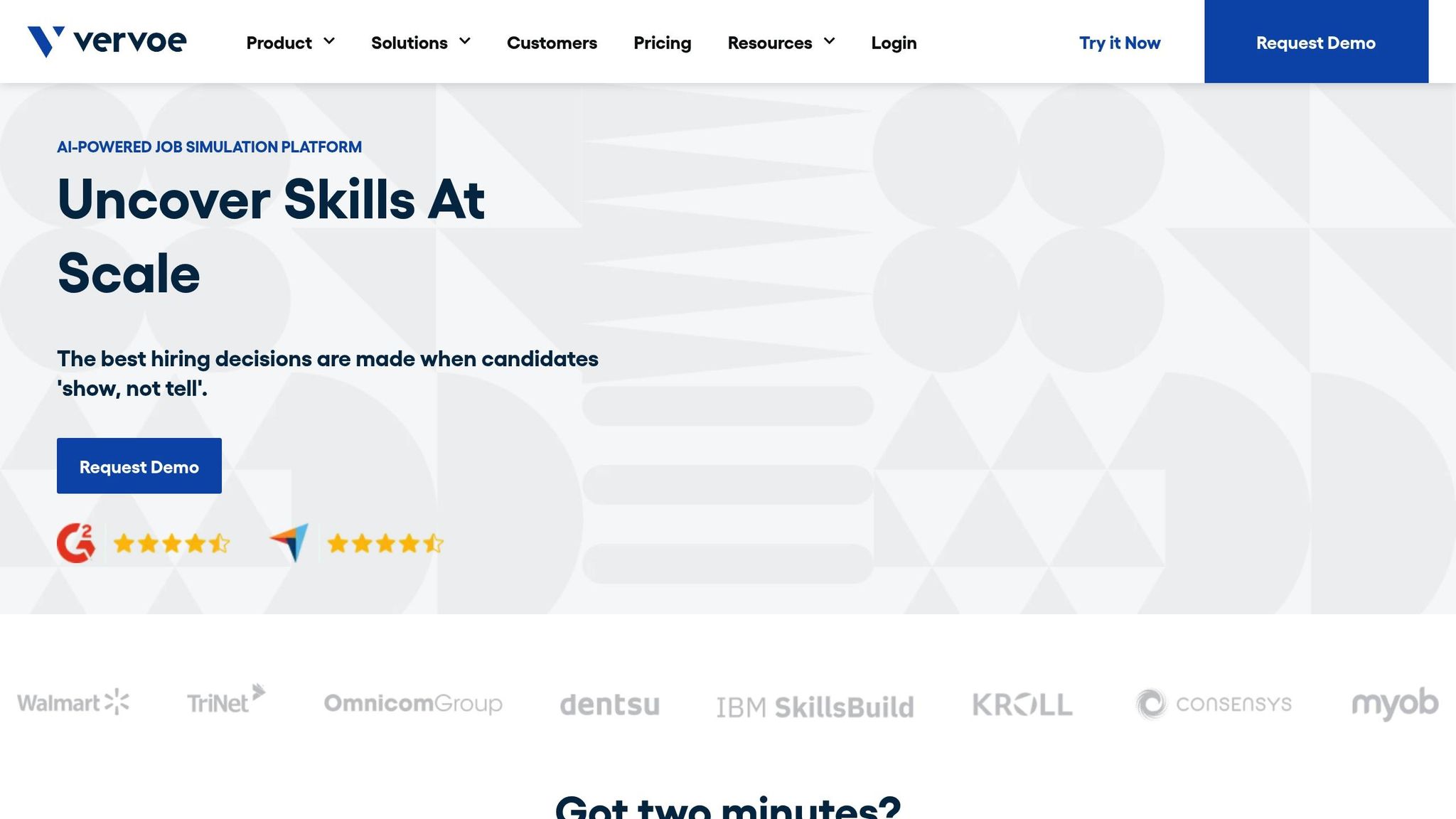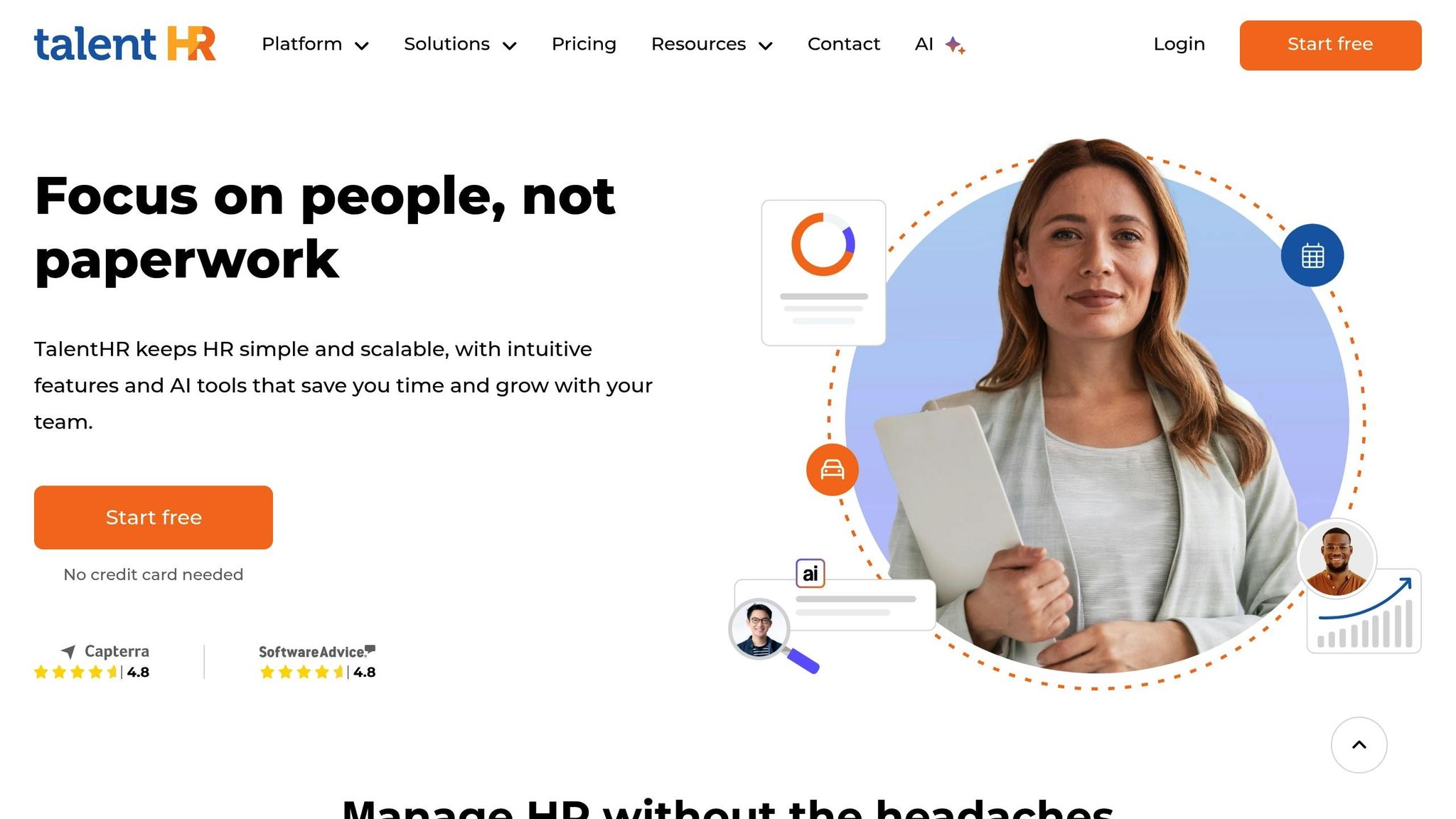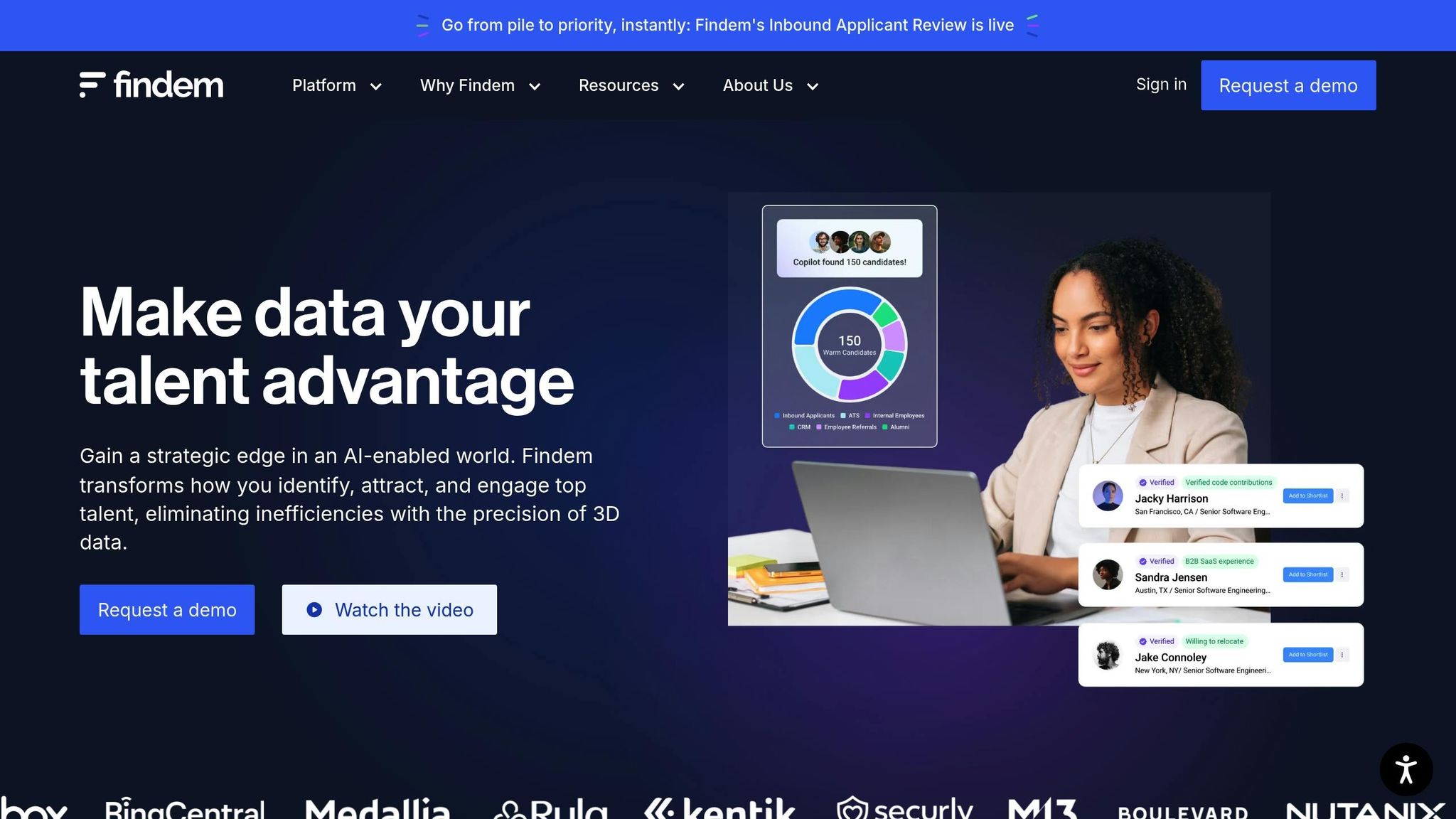AI hiring tools are changing recruitment. They cut costs, save time, and help find better candidates by focusing on specific job requirements. Here's what you need to know:
- Why it matters: Companies spend over 20 hours screening resumes per role. AI tools reduce this time by up to 70% and cut recruitment costs by 77.9%.
- What they do: These tools use role-specific scoring to match candidates to jobs, focusing on skills and assessments instead of resumes.
- Popular tools:
- Vervoe: Customizes tests for specific roles and uses a 0–10 scoring system.
- Testlify: Offers over 500 curated tests and integrates with 1,000+ ATS tools.
- TalentHR: Combines hiring and HR management with simple, role-focused scoring.
- Findem: Uses data from 1.6 trillion points to find and score candidates based on detailed profiles.
Quick Comparison:
| Tool | Strengths | Limitations | Best For |
|---|---|---|---|
| Vervoe | Highly customizable assessments | Time-intensive setup | Companies with unique role needs |
| Testlify | Large test library, ATS integration | May require extra integration effort | Skill-based hiring organizations |
| TalentHR | Simple scoring, HR integration | Lacks advanced AI features | Small to medium businesses |
| Findem | Advanced matching, detailed profiles | Higher costs, complex implementation | Large enterprises with complex needs |
AI hiring tools are transforming recruitment, but human oversight is still essential to ensure fairness and accuracy. Balancing AI insights with human judgment is the key to better hiring outcomes.
Recruiting Prompts: Create a Job Match Scorecard with Chat GPT from a Resume
1. Vervoe

Vervoe is an AI-driven platform designed to tailor candidate assessments to the specific demands of a role. Instead of relying on generic testing, it focuses on creating evaluations that align with the actual skills needed for the job. This approach provides a deeper understanding of a candidate's abilities.
Customization Level
Vervoe takes customization seriously. Its AI-powered Assessment Builder analyzes job descriptions to generate role-specific assessments automatically. On top of that, it offers a library of over 300 pre-built templates crafted by industrial and organizational psychologists. These templates can be adjusted by renaming skill groups, reordering questions, or adding entirely new categories to suit unique hiring needs.
For example:
- A front-end developer assessment might test JavaScript, HTML, and CSS skills while simulating real-world coding challenges.
- A marketing manager assessment could include creative portfolio reviews, scenario-based strategy evaluations, and tests for tools like Slack and Trello.
These tailored assessments feed directly into Vervoe's scoring system, ensuring that evaluations are not just relevant but also precise.
Key Scoring Features
Vervoe uses a straightforward 0–10 scoring system, divided into three categories:
| Score Category | Score Range | Description |
|---|---|---|
| Poor | 0–3 | Responses lack clarity, relevance, or depth and fail to meet basic expectations for the role. |
| Average | 4–7 | Answers meet minimum requirements but lack thoroughness, showing basic competency without mastery. |
| Excellent | 8–10 | Candidates provide detailed, insightful responses that exceed expectations and demonstrate expertise. |
The platform's AI grades responses by comparing them against millions of prior interactions. Recruiters can also manually evaluate candidates, with their scores averaged into the overall team assessment. To highlight top talent, Vervoe awards Top Performer badges to candidates in the top 5% and assigns trophy icons to the top three performers in each skill area.
This scoring system ensures a blend of automation and human oversight, making the evaluation process both efficient and reliable.
Data Integration
Vervoe simplifies hiring by automatically grading, ranking, and filtering responses. After candidates complete their assessments, the platform dynamically processes results, allowing recruiters to adjust scores as job requirements evolve. This flexibility ensures that the evaluation process stays relevant and accurate.
Transparency
Transparency is a key feature of Vervoe's approach. Recruiters receive detailed breakdowns of candidate performance across various skill areas. When manual grading is applied, those scores override AI predictions while simultaneously training the model for future assessments. This creates a feedback loop that refines the system over time.
Considering that up to 82% of employers use assessments to narrow their candidate pool, Vervoe’s combination of automation and human insight ensures hiring decisions are both data-driven and accountable. By offering detailed performance metrics and customizable tools, it empowers organizations to make confident, informed choices.
2. Testlify
Testlify is a hiring tool designed to go beyond traditional resume screening. Instead of relying solely on resumes, it evaluates job-readiness by focusing on real workplace tasks and responsibilities. With a library of over 500 curated tests tailored to various roles and industries, Testlify simplifies candidate evaluations by aligning assessments with actual job needs.
Customization Level
One of Testlify's standout features is its Role Specific Skill test creation. This tool allows recruiters to design assessments that target the exact skills required for a given role. For example, if you're hiring for a sales position, you can select key skills like Communication, Negotiation, and Presentation as part of the evaluation criteria.
The process is straightforward: recruiters choose the "Role Specific Skill" option, then use keyword filters - like "Sales" - to navigate Testlify's extensive question library. This makes it easy to craft customized assessments that align with the unique demands of any position.
Key Scoring Features
Testlify uses an AI-driven auto-scoring system to evaluate a range of question types, from multiple-choice to video interviews and chat simulations. This system generates instant reports that include benchmark comparisons, helping recruiters quickly identify top candidates. Each report provides a detailed breakdown of scores across individual skills, offering a clear picture of a candidate’s strengths and areas for improvement.
The platform also features an AI assessment builder, enabling recruiters to create role-specific evaluations that match job requirements. Companies using Testlify have reported impressive results, such as cutting time-to-hire by up to 82%, improving initial screening efficiency by 75%, and increasing hiring accuracy by 21%. These features integrate seamlessly with existing systems, making the hiring process more efficient.
Data Integration
Testlify integrates with over 1,000 ATS tools, eliminating the need for manual data entry. Candidate profiles, scores, and feedback automatically sync with ATS platforms, allowing recruiters to manage the entire hiring process from one place. The platform also offers customizable workflows, making it easy to incorporate assessments at any stage of the recruitment process.
Additionally, Testlify acts as a centralized communication hub within ATS systems. This means hiring managers can share results, collaborate on decisions, and provide feedback without switching between platforms.
Transparency
Testlify delivers detailed candidate report cards that go beyond basic pass/fail results. These reports include comparative performance data, helping recruiters see how candidates measure up against specific benchmarks.
Benjamin Marsili, Founder of Whire, highlights the platform’s practical benefits:
"Testlify's integration with ATS makes it simple to incorporate into recruitment processes. Customizable test suites, open-ended questions, and qualifying questions streamline the candidate assessment process and improve collaboration with hiring managers."
3. TalentHR

TalentHR takes candidate evaluation one step further by blending it seamlessly with broader HR management tasks. Acting as an all-in-one HR platform, it combines AI-powered recruitment tools with comprehensive employee management features, creating a unified solution for businesses.
Customization Level
TalentHR's AI tools allow you to fine-tune job postings and assessments to suit specific roles. With its job description generator and customizable screening questions, you can craft tailored hiring workflows that automatically update employee profiles as candidates move through the process .
Key Scoring Features
Once a job is set up, TalentHR’s scoring system gets to work. It analyzes candidate resumes against job descriptions, focusing on the most important skills for the role. Each candidate is then assigned a suitability score ranging from 0 to 10, along with a summary of their key qualifications . This standardized scoring ensures consistent evaluations across all roles and hiring managers, making it especially useful for companies handling a high volume of applications .
Data Integration
TalentHR eliminates the hassle of dealing with disconnected systems by integrating with over 7,000 apps through Zapier. It also works directly with popular tools like Slack, Google Workspace, and WordPress, making onboarding and collaboration smoother. For businesses with unique needs, the platform’s open API allows for custom integrations and effortless data sharing between systems.
Transparency
One of TalentHR’s standout features is its commitment to clarity. The platform provides detailed candidate summaries that clearly explain how each applicant meets the job criteria. This transparency ensures hiring managers can easily understand the reasoning behind every evaluation. Anna N., Co-founder & CEO, shared her experience:
"This product is user-friendly and straightforward for employees, managers, and HR professionals to use. Furthermore, it was seamlessly integrated into our existing processes, ensuring a smooth transition and minimal disruption."
Users also consistently highlight the platform’s excellent customer support. Chelsea W., People Administrator, remarked:
"We would also like to compliment the amazing help desk, who are always willing to help...they offer quick replies and extensive knowledge of the platform."
With its focus on transparency and customer support, TalentHR has earned high user satisfaction scores, including 4.7/5 for both ease of use and customer support.
sbb-itb-96bfd48
4. Findem

Findem takes a unique approach to candidate evaluation by leveraging a 3D data model that matches profiles with role-specific scoring systems. Instead of relying on basic keyword searches, it analyzes 1.6 trillion data points from over 100,000 sources to build comprehensive candidate profiles. These profiles go far beyond traditional resume parsing, offering a deeper look into each candidate's attributes.
Customization Level
Recruiters using Findem can design ideal candidate profiles that factor in more than just skills and experience. The platform allows for the inclusion of traits like loyalty, proven success in similar roles, and experience guiding companies through IPOs. Once these attributes are defined, Findem automatically creates dynamic talent pools, updating them continuously as new candidates meet the specified criteria.
The platform also provides advanced filters for narrowing down candidates based on specific backgrounds, such as experience in financial services, particular funding stages, or IPO involvement. For instance, recruiters can identify individuals who have worked at fast-growing SaaS startups or those familiar with specific tech stacks. These tailored profiles feed into Findem's sophisticated scoring system to provide precise matches.
Key Scoring Features
Findem's scoring system uses 3D data signals to link individual and company data, offering a highly accurate assessment of each candidate's qualifications, career trajectory, and potential impact. Its Enhanced Candidate Review feature assigns match scores based on verified technical skills, relevant experience, and career growth, while also providing clear explanations for each score using intuitive filters.
For example, a Silicon Valley software company looking to double its workforce utilized Findem to prioritize candidates with SaaS product expertise and a startup mindset. The results were striking: 65% of their hires came from Findem, they faced zero offer rejections, and they improved their talent pipeline quality by tenfold.
Data Integration
Findem integrates seamlessly with major ATS platforms, offering features like ATS rediscovery, data enrichment, applicant scoring, profile deduplication, and candidate refresh. It can instantly pull relevant profiles from an ATS and enrich them with additional data, scoring and ranking candidates automatically while removing duplicates. This eliminates the need for manual reviews and significantly streamlines the search process.
Transparency
Transparency is a cornerstone of Findem’s approach. Unlike many AI tools that operate as a "black box", Findem clearly explains why candidates match specific criteria. This openness has had a tangible impact: companies report that 90% of candidates sourced through Findem are excellent interview prospects, and recruiters save an average of 1.5 days per week. By providing clarity in candidate evaluation, Findem simplifies the hiring process and helps businesses identify top talent with greater confidence.
Advantages and Disadvantages
AI recruitment tools each come with their own strengths and challenges, making it essential to weigh these trade-offs when choosing the right fit for your hiring needs.
Vervoe stands out for its flexibility, offering fully customizable assessments that allow employers to personalize tests, adjust questions, and incorporate branding. This makes it a great option for companies with unique roles or a strong emphasis on branding. However, this level of customization can be time-consuming to set up, which might be difficult for smaller teams without dedicated HR resources.
Testlify offers a broad library of skill assessments and an easy-to-navigate interface. However, integrating it with existing recruitment workflows may require extra effort, potentially leading to fragmented data processes.
TalentHR provides a simple, user-friendly scoring system tailored to specific roles. This makes it appealing to small and medium-sized businesses looking for straightforward solutions. That said, it may fall short for organizations that need advanced AI features to handle more complex hiring needs.
Findem delivers impressive candidate matching, earning ratings of 4.7/5 on G2 and 4.3/5 on Capterra. But its thorough approach often comes with higher costs and added complexity, which may not suit organizations with limited budgets or resources.
While these tools can significantly improve hiring efficiency, they come with challenges like bias and technical hurdles. Algorithmic bias, for instance, remains a concern, with 41% of AI systems exhibiting bias, and 85% of Americans expressing worry about fairness in AI. This highlights the need for rigorous oversight and ethical practices.
On the technical side, implementation can be tricky. Around 64% of organizations report deployment issues, and data breaches cost an average of $4.45M. Adequate IT support and robust data security measures are critical to addressing these risks.
Despite these challenges, when implemented properly, AI recruitment tools can have a transformative impact. They can drastically cut down recruiter workloads by quickly generating shortlists of qualified candidates. For example, Electrolux achieved an 84% rise in application conversion rates, a 51% drop in incomplete applications, and a 9% reduction in time-to-hire after adopting AI-driven fit scoring. Similarly, Brother International saw a 140% boost in completed applications within just three weeks.
Here’s a quick comparison of the tools:
| Tool | Strengths | Limitations | Best For |
|---|---|---|---|
| Vervoe | Fully customizable assessments with employer branding options | Time-intensive setup for small teams | Companies with unique roles and strong branding |
| Testlify | Broad skill assessment library and intuitive interface | May require extra integration work | Organizations focused on skill-based hiring |
| TalentHR | Simple, role-specific scoring system | Lacks advanced AI features | Small to medium businesses seeking simplicity |
| Findem | Strong candidate matching with high ratings | Higher costs and complex implementation | Large enterprises with intricate hiring needs |
To make the most of these tools, organizations should balance AI’s efficiency with human oversight. While AI excels at screening and matching candidates based on qualifications, human involvement is still essential for assessing nuanced skills and workplace fit. Establishing ethical guidelines, conducting regular audits, and maintaining alternative evaluation methods can help ensure fair and effective hiring practices. This balanced approach allows AI to complement, rather than replace, human judgment in the recruitment process.
Final Thoughts
AI-powered, role-specific candidate scoring is transforming hiring processes, cutting costs by an impressive 67% and reducing screening times from 23 hours to just minutes.
Companies like Unilever and Hilton Worldwide are already seeing the benefits. Unilever's AI-driven video interview assessments have boosted hiring managers' satisfaction by 50% while speeding up time-to-hire. Hilton's tailored AI assessments have helped reduce employee turnover by 25%. Meanwhile, Chipotle Mexican Grill's AI assistant, "Ava Cado", has increased application completion rates from 50% to 85% and slashed hiring timelines for 20,000 seasonal roles from 12 days to just 4.
"The AI agent is designed to figure out if you're a good fit for the job, and frankly, I think it does a better job than humans. It does it faster and more effectively, and it does it in a bias-free way."
– Sean Behr, CEO of Fountain
These examples underscore the importance of adopting AI strategically, especially as the market for AI hiring tools is projected to grow from $610 million in 2022 to over $1.2 billion by 2027. However, this rapid evolution comes with challenges. While 76% of recruiters find AI assessments more insightful than traditional methods, 71% of Americans oppose AI making final hiring decisions, and 66% of job seekers remain skeptical. Transparency, customization, and data privacy are critical factors for success in this space.
Striking the right balance between AI insights and human judgment is essential. Choosing platforms that clearly explain their decision-making processes and allow for role-specific adjustments can make all the difference.
"Responsible AI use doesn't mean avoiding AI - it's about balancing risks and opportunities. The real danger lies in either ignoring AI or adopting it recklessly - both diminish your ability to do your job effectively."
– Trey Causey, Senior Director of Responsible Technology at Indeed
AI's ability to deliver data-driven assessments is also reshaping efficiency. For instance, Goldman Sachs processes over one million job applications annually with AI tools, and Elevance Health has achieved a 30% reduction in employee turnover using gamified assessments. These results highlight how AI can predict job performance, retention potential, and even cultural fit, offering businesses a smarter, faster way to make hiring decisions.
FAQs
How do AI tools promote fairness and reduce bias in candidate scoring?
AI tools help ensure fairness in hiring by emphasizing objective and anonymized evaluations. They strip away personal details like names, photos, and demographic information, allowing hiring decisions to focus purely on a candidate’s skills, qualifications, and experience.
Many of these tools also incorporate fairness metrics designed to identify and address potential biases. This enables recruiters to make decisions that are more equitable. By standardizing the evaluation process, AI creates a fairer system for all candidates, promoting diversity and inclusion in hiring practices.
What challenges might companies face when adopting AI tools for hiring?
Challenges of Implementing AI Hiring Tools
Using AI in hiring processes comes with its own set of hurdles. A key issue is bias in decision-making. AI systems can unintentionally favor or disadvantage certain groups of candidates, leading to unequal opportunities. This often happens because the training data used to build these tools might carry hidden biases, which the AI then learns and replicates.
Another challenge is the lack of transparency in how these tools operate - commonly called the "black box" problem. When it's unclear how AI reaches its decisions, it can lead to trust issues and make it harder for companies to comply with hiring laws and regulations.
To tackle these problems, organizations need to actively monitor their AI systems, commit to ethical practices, and focus on making the decision-making process as transparent as possible. This approach can help create a fairer and more trustworthy recruitment process.
How can companies combine AI insights with human judgment in hiring decisions?
Companies can strike the right balance between AI-powered insights and human judgment by leveraging AI for tasks that demand speed and efficiency, like screening resumes, ranking candidates, and analyzing data. Meanwhile, human input should focus on aspects that require a more nuanced understanding, such as evaluating soft skills, assessing alignment with company values, and making the final hiring decisions.
To keep the process fair and accurate, businesses should routinely review AI-generated recommendations and compare them with actual hiring results. This ensures AI serves as a tool to enhance human decision-making, boosting efficiency while preserving the critical human touch in recruitment.


